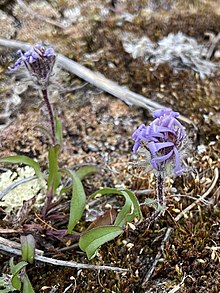Symphyotrichum pygmaeum (original) (raw)
From Wikipedia, the free encyclopedia
Species of flowering plant in family Asteraceae
| Symphyotrichum pygmaeum | |
|---|---|
 |
|
| Victoria Island, Kitikmeot Region, Nunavut, Canada | |
| Conservation status | |
 Apparently Secure (NatureServe)[1] Apparently Secure (NatureServe)[1] |
|
| Scientific classification |
|
| Kingdom: | Plantae |
| Clade: | Tracheophytes |
| Clade: | Angiosperms |
| Clade: | Eudicots |
| Clade: | Asterids |
| Order: | Asterales |
| Family: | Asteraceae |
| Tribe: | Astereae |
| Subtribe: | Symphyotrichinae |
| Genus: | Symphyotrichum |
| Subgenus: | Symphyotrichum subg. Virgulus |
| Section: | Symphyotrichum sect. Grandiflori |
| Species: | S. pygmaeum |
| Binomial name | |
| Symphyotrichum pygmaeum(Lindl.) Brouillet & Selliah[2] | |
 |
|
| Native distribution[3] | |
| Synonyms[2] | |
| Basionym Aster pygmaeus Lindl. Other synonyms Aster sibiricus subsp. pygmaeus (Lindl.) Á.Löve & D.Löve Aster sibiricus var. pygmaeus (Lindl.) Cody Eurybia pygmaea (Lindl.) G.L.Nesom |
Symphyotrichum pygmaeum (formerly Eurybia pygmaea and Aster pygmaeus) is a species of flowering plant in the family Asteraceae. Commonly known as pygmy aster, it is a perennial, herbaceous plant that may reach heights of 1.5 to 15 centimeters (1⁄2 to 6 inches). Its summer-blooming flowers have purple to violet ray florets and yellow disk florets.[4]
Distribution and habitat
[edit]
S. pygmaeum is native to north Alaska, Northwest Territories, and Nunavut, and it grows at up to 200 meters (660 feet) or more above sea level in moist sand dunes, sandy or silty stream banks, gravelly tundra, and similar habitats.[4]
As of December 2022[update], it was classified by NatureServe (as Eurybia pygmaea) as Apparently Secure (G4) globally; Apparently Secure (S4) in Northwest Territories and Nunavut; and, Imperiled (S2) in Alaska. Its global status was last reviewed by NatureServe on 23 June 2016. Several known locations of the plant, especially in Alaska, are near oil field developments, increasing the potential threat to its survival in those areas. "The sand and gravel sites favored by this species are [...] prized for material sites by mineral and oil exploration and development companies."[1]
S. pygmaeum herbarium specimen
S. pygmaeum herbarium specimen close-ups
- ^ a b NatureServe (2022).
- ^ a b POWO (2022).
- ^ Semple (2014).
- ^ a b Brouillet et al. (2006).
- Brouillet, L.; Semple, J.C.; Allen, G.A.; Chambers, K.L.; Sundberg, S.D. (2006). "Symphyotrichum pygmaeum". In Flora of North America Editorial Committee (ed.). Flora of North America North of Mexico (FNA). Vol. 20. New York and Oxford: Oxford University Press. Retrieved 1 November 2022 – via eFloras.org, Missouri Botanical Garden, St. Louis, MO & Harvard University Herbaria, Cambridge, MA.
- NatureServe (3 December 2022). "Eurybia pygmaea Pygmy Wood-aster". explorer.natureserve.org. Arlington, Virginia. Retrieved 7 December 2022.
- POWO (2022). "Symphyotrichum pygmaeum (Lindl.) Brouillet & Selliah". Plants of the World Online. Royal Botanic Gardens, Kew. Retrieved 1 November 2022.
- Semple, J.C. (21 February 2014). "Symphyotrichum pygmaeum Pygmy Aster". www.uwaterloo.ca. Ontario. Archived from the original on 23 July 2021. Retrieved 10 September 2021.

